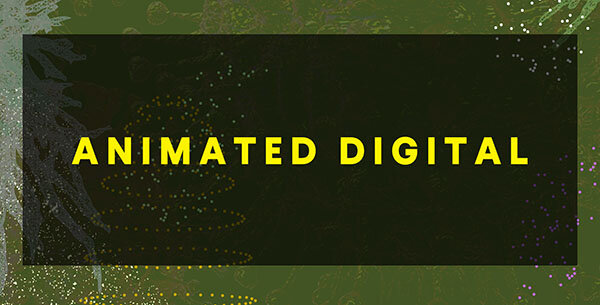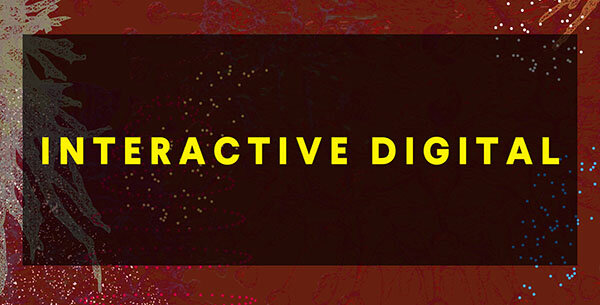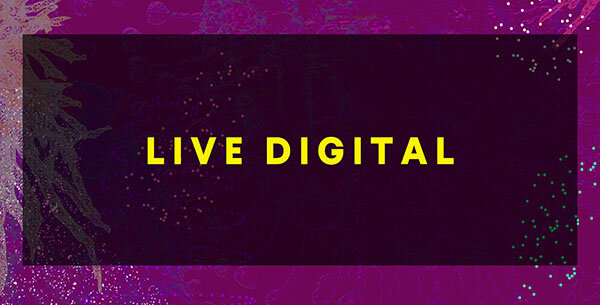DYSCORPIA 2.1
ANIMATED
DIGITAL
ARTISTS: Jason Abma, Hailey Brancato, Megan Beland, Kairu Fan, Erin Gee, Beverly Hood, Danielle Imara, Alicja Habisiak-Matczak, Liz Ingram and Bernd Hildebrant, Marilyn Langevin and Thomas Fenton, Sydney Lancaster, Kevin Liang, Veronika McGinnis, Gabriel Esteban Molina, Oksana Movchan and Gary James Joynes, aAron Munson, Darian Goldin Stahl, eryn tempest, Becky Thera, Joan Greer, Sourayan Mookerjea and Tegan Moore.
Machine Unlearning (Excerpts) by Erin Gee
In Machine Unlearning, the artist offers a neural conditioning treatment by whispering the unraveling outputs of an LSTM algorithm to the viewer. The combination of machine learning and ASMR draws parallels between autonomous algorithms and the autonomous functions of the human body.
To see the full version please on the title above.
Time-lapse of the 25 Days by Megan Beland
Megan chose a place in a forest where tall grass and weeds dominated the landscape and staked out an area with pegs and rope that was 66 inches square. Megan trimmed the grass and raked the ground, manipulating and putting her mark on the environment. During this time of Covid and isolation, the project took on additional meaning. While people are confined to their homes and restricted to online contact, the natural world outside continues on without us. Without our interaction with it and a reduced impact on it, the environment is thriving. It is evident that the environment does not need us but we can’t survive without it.
Chaotic Bodies: Touch Data Space by Sydney Lancaster
Sonified amino acids & protein folds reveal patterns: avenues for a vaccine? Visualizing connections. Touch, now absent. What is the body’s role, now? Does access to technology & vast amounts of data contribute to making sense of a world replete with chaotic events? Or does it compound isolation and chaos for individual bodies?
Further Back & Faster by aAron Munson
Looking closer at the nature of all things, might we see paths outside the inherited mental frameworks that leave us at the mercy of our minds. Further back and faster.
Les Arbes qui nous Prennent / The Trees that Hold Us by eryn tempest
Les Arbes qui nous Prennent is an experimental dance film that explores the nature of embodiment in terms of fragmentation, trace, mutation, and decay. The work reimagines the body as an unfamiliar landscape whose discovery evokes notions of space travel and alien visitation.
Drifting Logbook 01 by Kevin Liang
Through these explorations of drifting in an urban environment, Kev Liang ponders the vague notion of bodied presence in the face of technological dependency. How is our perception of space and time altered due to these uncertain living conditions coupled with our own biases and traumas?
Nowhere To Run by Danielle Imara
Nowhere To Run refers to the frustration of being alone, or worse, trapped in unhealthy and unsafe domestic environments during the Covid-19 Lockdown 2020. Reflecting the surreality of the crisis the legs are in constant motion yet cannot travel. They are purple with stasis. They are disembodied and bruised. They are cut off, dehumanized in a world turned upside-down. They are an itch, an urge to move, to run, to go somewhere, when there is nowhere to go. These are secret interior responses, that can’t be shared via Zoom, phone calls or letters.
Time seems to pass in a non-linear fashion, feeling distorted and surreal (while ultimately slipping away quickly and quietly.) Clutter starts to build up over time as we are confined to our homes; our private spaces become something entirely different. Smaller, nest- like environments within our larger living spaces develop, with everything within arm’s reach.
Tactile Transmission by Darian Goldin Stahl
Tactile Transmission by Darian Goldin Stahl is a digital short using prints from her artist's book that animate the significance of touch between humans and rodents between the middle ages versus today: rodent bodies that once transmitted disease are now the bodies that will manifest a vaccine.
Trip 1 - Hasta La Vista by Gabriel Esteban Molina
Gabriel Esteban Molina is concerned with the influence of technology on our perception of the natural world. Inspired by alternative culture, quantum physics and esotericism in the 21st century, Gabriel's work explores the unintentional phenomena resulting from the interactions of different visual devices and how they relate to the natural processes which underlay our universe. By experimenting with the physical interactions of different cameras and displays, Gabriel focuses attention to the materiality of the screen and playing with the tension between real and virtual, analog and digital, and traditional and contemporary.
Untouchable Spaces by Alicja Habisiak-Matczak
Untouchable Spaces is a series of charcoal drawings in which Alicja Habisiak-Matczak depicts the spaces of airports, train stations, underground staircases which normally are extremely crowded and noisy, full of constant motion. Suddenly all these corridors, halls and staircases became still and empty. The rails, knobs, which we normally touched almost unconsciously, now more then ever become a symbol of invisible danger, in a way they became untouchable...
Wake Up, Star Seed by Veronika McGinnis
Veronika McGinnis has been building world's which allow her to explore reality through altered states of consciousness. Although, despite these interventions, Veronika is ultimately pulled back into reality through an embodied relationship to physical pleasure and human suffering. Through the use of induced trance and meditation, Veronika experiences visions which come to the surface of her mind. Wake Up, Star Seed is a physical expression of her inner thoughts. It explores a stream of consciousness in the hopes of achieving mindfulness through magick; while processing guilt and loss.
With the rapid onset of the pandemic, the emergence of new protocols and measures have effectively changed our routine norms. Social distancing has not only physically isolated us, but emotionally isolated us. People are afraid of socializing – they no longer greet each other, they move around each other in unusual ways, they avoid people who wear masks – the threat of contracting COVID-19 has dehumanized our social relationships. In this durational work, Kairui Fan repeats the action of layering masks on his face. Kairui Fan expresses how isolation has restricted and regulated the way Kairui navigates relationships with others and the world, both physically and emotionally.
Yearn by Marilyn Langevin and Thomas Fenton
Marilyn Langevin and Thomas Fenton are classmates in the Bachelor of Fine Arts program at the University of Alberta. As studio mates they came to appreciate each other’s energies, ideas, and works. This collaborative project was their way to stay connected during COVID-19 isolation. This work is about yearning, aching for touch –that human connection that transcends all of the ways in which we try to emulate it. Now more than ever, seclusion weighs heavier on us. We seek reconnection.
Into The Garden We Go… by Oksana Movchan and Gary James Joynes
Movchan’s 2019 acrylic diptych entitled “That, that is not a Man” and “That, that is not a Woman” (exploring male and female energy) has been re-imagined in this short film work. Placed in nature and superimposed into an ambient video painting, new oscillations occur when combined with Joynes’ slow-art sound and video composition sensibilities.
Immobile Choreography by Beverley Hood
Immobile Choreography is an installation using video projection, 3D prints, LED light and audio. The installation focuses on the potential of imaginatively materialising the body through the FFC-MRI process and apparatus; which makes immaterial our material bodies. The project poetically re-imagines the physical experience of and movement within the parameters of the scanner apparatus; what would this movement might be and how this relates to the effect of the magnetic resonance imaging process on our bodies.
Breathing Resonance by Liz Ingram and Bernd Hildebrandt
In Breathing Resonance, Liz Ingram’s MRI brain scans, her body, her breathing, and a flowing creek unite to humanize a technological and somewhat alienating event recently experienced by her when undergoing amazing gamma knife brain surgery during the COVID-19 lockdown.
Jason Abma’s work explores the fabricated, virtual world created in the future, by the fictional corporation D.I.S. TECH. Digital Imprint Storage Technology has enabled the upload of humans into this endless realm in an attempt to defeat our mortality. Abma’s paintings, prints, and animations intend to explore the morality of technology and its influence on what it means to be human in our digital era.
Seed Time: Sister Plantings for Regenerative Energy Futures by Joan Greer, Sourayan Mookerjea and Tegan Moore
Seed Time enables us to think of the human and more-than-human body ecologically, as process in the web of life. In its current COVID-time iteration, the nucleic video-poem cycle of Seed Time holds traces of a former embodied and intermedia whole. Seed time is composed of memory-storage, dispersal, pyriscence, imbibition, respiration, light, mobilization, sprouting, growth, and regeneration through which negentropic common-being creates a place for Earth-bound lifetimes, giving wisdom, taking care and creating common wealth.
Me: I Miss You by Jane Eyre Jordans
Me: I Miss You is a short animated video that explores the limits of the body within the context of screen mediated relationships.
Jane Eyre Jordans is an emerging artist whose work has dealt with themes of intimacy in the digital age, subject object relationships and identity, the body, space, sex and sexuality, and critical mixed race theory.
Pose of a Person by Siavash Naghshbandi
Control and surveillance systems are expanding and are using artificial intelligence to learn human behaviour. Fan-sofa-laptop-pot-table-drinking water-light-book-cellphone-movie-watching a movie-speaking-dressing up-eating-talking-photo frame-bathing-carpet-internet-watering flowers-looking outside-washing dishes-brushing-sleeping-... For the past six months I had a camera set up in my apartment that recorded every movement using its motion detection feature.
How the World fell in Between the Cracks
How the World fell in Between the Cracks is a dual channel video that speaks to mass surveillance taking on a new meaning during the pandemic and the dystopian gap between hefty corporate investments and injection of funds into vital services such as healthcare that is pushing us to the edge of social, political and economic disaster. Mona Hedayati is an Iranian-Canadian artist particularly interested in visual-verbal hybrid investigations exposing systems of power. Hedayati has exhibited and presented on her work internationally and across Canada and her practice has been supported by Social Sciences and Humanities Research Council and BC Arts Council.


























